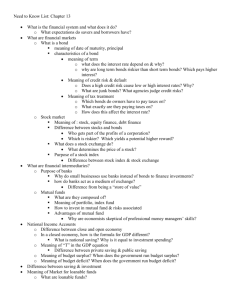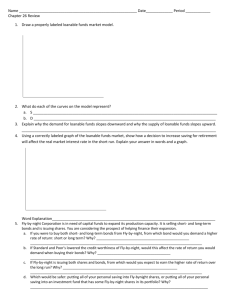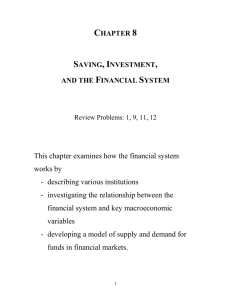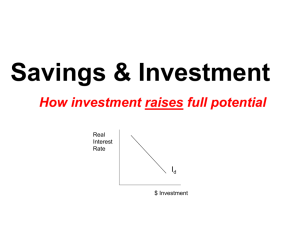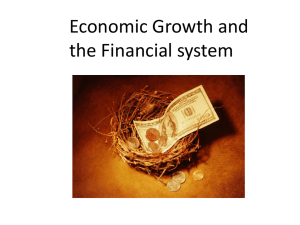Chapter 13 Saving, Investment, and the Financial System
advertisement
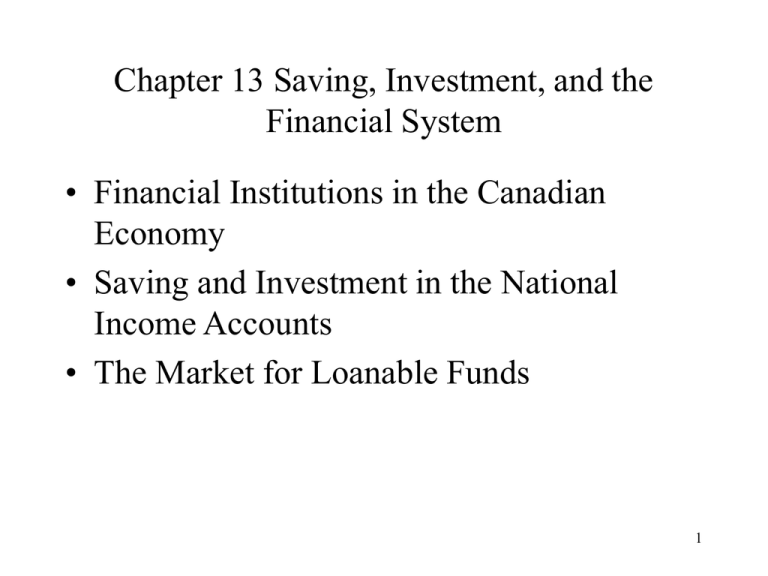
Chapter 13 Saving, Investment, and the Financial System • Financial Institutions in the Canadian Economy • Saving and Investment in the National Income Accounts • The Market for Loanable Funds 1 • The Financial system consists of those institutions in the economy that help to match one person’s saving with another person’s investment. Financial institutions in the Canadian Economy • At the broadest level, the financial system moves the economy’s scarce resources from savers ( people who spend less than they earn) to borrowers ( people who spend more than they earn). • Savers save for various reasons: children’s education fund, retirement fund, etc. • Savers supply their money to the financial system with the expectation that they will get it back with interest at a later date. • Borrowers demand money from the financial system with the knowledge that they will be required to pay it back with 2 interest at a later date. • Financial institutions can be grouped into two categories: financial markets and financial intermediaries. • Financial markets: are the institutions through which a person who wants to save can directly supply funds to a person who wants to borrow. Two most important financial markets: the bond market and the stock market. The Bond Market: • A bond is a certificate of indebtedness that specifies the obligations of the borrower to the holder of the bond. Put simply, a bond is an IOU. Characteristics of a bond: – Term: the length of time until maturity. Short terms: a few months & Long terms: up to 30 years. The British government has even issued a bond that never matures, 3 called a perpetuity. This bond pays interest forever, but the principal is never repaid. • Long term bonds are riskier than short term bonds because holders of long term bonds have to wait longer for repayment of principal. To compensate for this risk, long-term bonds usually pay higher interest rates than short-term bonds. – Credit Risk: the probability that the borrower will fail to pay some of the interest or principle. Such a failure to pay is called a default. Borrowers can ( and sometimes do) default on their loans by declaring bankruptcy. When bond buyers perceive that the probability of default is high, they demand a higher interest rate to compensate them for this risk. • Eg, Federal government bonds tend to pay low interest 4 rates because of a safer credit risk. • Financially shaky corporations raise money by issuing junk bonds, which pay considerably higher interest rates than government bonds. • Buyers of bonds can judge credit risk by checking with various private agencies such as Standard & Poor’s, which rate the credit risk of different bonds. – Tax Treatment: The interest on most bonds is taxable income. The Stock Market Stock represents ownership in a firm, thus the owner has claim to the profits that the firm makes. The sale of stock to raise money is called equity finance, where the sale of bonds is called debt finance. Compared with bonds, stocks offer the holder both a higher risk and a potentially higher return. Why? 5 Markets in which stock is traded: – Toronto Stock Exchange (TSE) – New York Stock Exchange – NASDAQ (National Association of Securities Dealers Automated Quotation System) • Various stock indexes are available to monitor the overall level of stock prices. A stock index is computed as an average of a group of stock prices. The most famous stock index is the Dow Jones Industrial Average, which has been computed regularly since 1896. 6 Financial Intermediaries: are financial institutions through which savers can indirectly provide funds to borrowers. The term intermediary reflects the role of these institutions in standing between saver and borrowers. Two of most important financial intermediaries-Banks and Mutual Funds. Banks: A primary job of banks is to take in deposits from people who want to save and use these deposits to make loans to to people who want to borrow. • Besides being financial intermediaries, banks play a second important role in the economy: they facilitate purchases of goods and services by allowing people to write cheques against their deposits. In other words, banks help create a special asset that people can use as a medium of exchange. 7 Mutual Funds • A mutual fund is an institution that sells shares to the public and uses the proceeds to buy a selection, or portfolio, of various types of stocks, bonds, or both stocks and bonds. • The shareholder of the mutual fund accepts all of the risk and return associated with the portfolio. If the value of the portfolio rises, the shareholder benefits; if the value of the portfolio falls, the shareholder suffers the loss. • The primary advantage of mutual funds is that they allow people with small amounts of money to diversify. “ Don’t put all your eggs in one basket.” • A second advantage claimed by mutual fund companies is that mutual funds give ordinary access to the skills of professional money managers. 8 Other financial intermediaries include: – Savings and Loans Associations – Credit Unions – Pension Funds – Insurance Companies – Loan Sharks 9 Saving and Investment in the National Income Accounts Recall: GDP is both total income in an economy and the total expenditure on the economy’s output of goods and services: Y = C + I + G + NX Assume a closed economy:Y = C + I + G National Saving or Saving: the total income in the economy that remains after paying consumption and government purchase. Saving is equal to: Y - C - G = I = S National Saving or Saving is equal to: Y - C - G = I = S or S = (Y - T - C) + (T - G) where “T” = taxes net of transfers Two components of national saving: Private Saving = (Y - T - C) 10 Public Saving = (T - G) Private Saving is the amount of income that households have left after paying their taxes and paying for their consumption. Public Saving is the amount of tax revenue that the government has left after paying for its spending. For the economy as a whole, saving must be equal to investment. Budget surplus: an excess of tax revenue over government spending Budget deficit: a shortfall of tax revenue from government spending 11 The Market for Loanable funds Financial markets co-ordinate the economy’s saving and investment in The Loanable Funds Market The Supply of Loanable Funds comes from people who have extra income that they want to loan out. The Demand for Loanable Funds comes from those who wish to borrow to make investments. See Figure 13-1 on page 275. • The interest rate is the price of loan. It represents the amount that borrowers pay for loans and the amount that lenders receive on their saving. Because a high interest rate makes borrowing more expensive, the quantity of loanable funds demanded falls as the interest rate rises. Similarly, because a high interest rate makes saving more attractive, the quantity of loanable funds supplied rises a the interest 12 rate rises. • So, downward sloping for demand curve and upward sloping for supply curve for loanable funds. • Because inflation erodes the value of money over time, the real interest rate more accurately reflects the real return to saving and cost of borrowing. • Therefore, the supply and demand for loanable funds depend on the real interest rate and the equilibrium in Figure 13-1 should be interpreted as determining the real interest rate in the economy. Government Policy That Affects The Economy’s Saving and Investment. • Policies that influence the loanable funds market: – Taxes and Saving – Taxes and Investment – Government Budget Deficits/Surpluses 13 Observe how policy affects equilibrium, interest rates and funds. Policy 1: Taxes and Saving See Figure 13-2 on page 278 (a change in the tax laws to encourage Canadians to save more) Taxes on savings reduce the incentive to save. A tax decrease would alter the incentive for households to save at any given interest rate and would affect the supply of loanable funds resulting in the: – Supply curve shifting to the right. – Equilibrium interest rate would drop. – Quantity demanded for funds would rise. 14 Policy 2: Taxes and Investment See Figure 13-3 on page 279 Suppose that Parliament passed a law giving a tax reduction to any firm building a new factory. A Tax Break on investment would increase the incentive to borrow if an investment tax credit were given. An investment tax credit would: – Alter the demand for loanable funds. – Cause the demand curve to shift to the right. – Result in a higher interest rate and greater saving. 15 Policy 3: Government budget deficits and surplus See Figure 13-4 on page 281 • When the government spends more than it receives in tax revenues the accumulation of past budget deficits is called the government debt. The budget deficit: – Alters the supply curve, reducing supply. – Causes the supply to shift to the left. – Results in Crowding Out. When the government borrows to finance its budget deficit, it reduces the supply of loanable funds available to finance investment by households and firms. This deficit borrowing “crowds out” the private borrowers 16 who are trying to finance investments. A budget surplus increases the supply of loanable funds, reduces the interest rate, and stimulates investment. Vicious circle: cycle that results when deficits reduce the supply of loanable funds, increase interest rates, discourage investment, and result in slower economic growth; slower growth leads to lower tax revenue and higher spending on income-support programs and the result can be still higher budget deficits. Virtuous circle: cycle that results when surpluses increase the supply of loanable funds, reduce interest rates, stimulate investment, and result in faster economic growth; faster growth leads to higher tax revenue and lower spending on income-support programs and the result can be still higher budget surpluses. 17 See Figure 13-5 on page 283
